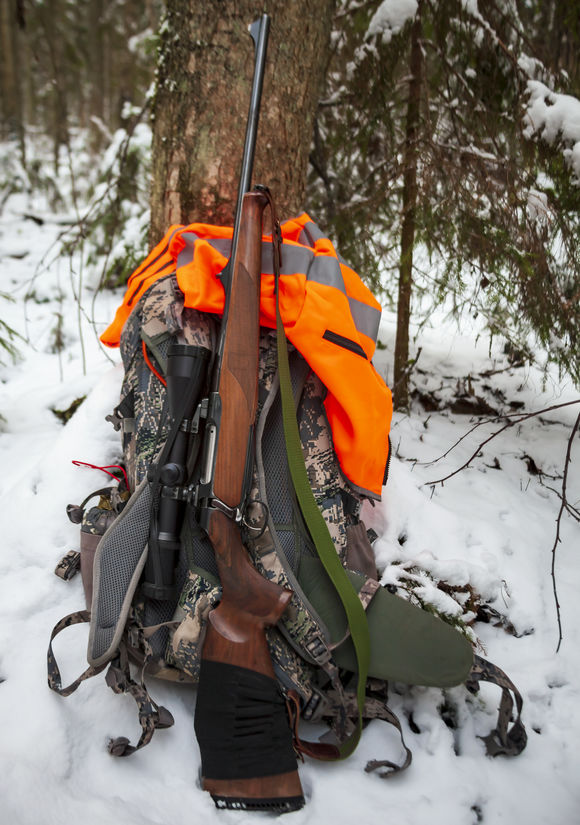
When you’re headed out for a remote moose hunt, packing isn’t something you’ll want to leave for the last minute. When you’re flying into camp, there’s no running to the store if something gets left behind. Every piece of gear matters—not just for comfort, but for safety, efficiency, and giving yourself the best shot at success. Here at Mattice Lake Outfitters, we know that having the right equipment can make or break your moose hunting experience. Here’s what we think you should keep in mind:
Essential Hunting Gear
Start with your weapon of choice and build out from there. If you’re using a rifle, make sure it’s powerful enough for large game—moose aren’t animals you want to take chances on. Most hunters opt for something in the .30 caliber range or larger. If you’re bowhunting, draw weight, arrow setup, and broadhead choice all become especially important when dealing with thick hide and heavy bone.
Don’t underestimate the value of good optics. A quality set of binoculars will help you glass from a distance without giving away your position. Some hunters also bring a spotting scope, especially if they’re hunting open terrain or ridges where long-distance viewing comes into play. Game calls can make a big difference during the rut. Cow calls and bull grunts help draw in moose that might otherwise stay hidden. Pack a few and practice ahead of time—when used right, they can be your most effective tool.
It’s also a good idea to carry a rangefinder, especially in dense or uneven terrain. It’s also a good idea to carry a rangefinder, especially in dense or uneven terrain. Estimating distance across water, through bush, or downhill can throw you off without one. Of course, you should also bring anything you’ll need for the license or tag.
Clothing That Works in the Bush
Weather in Northwestern Ontario can shift quickly, and conditions in September or October can range from mild to cold, with a good chance of rain. Layering is absolutely crucial. You start with a moisture-wicking base layer, add insulation like fleece or wool, and top if off with a waterproof, windproof shell. Your boots matter just as much as your weapon. You’ll be walking through wet ground, moss, and shoreline muck. Waterproof boots with good ankle support and insulation are worth the investment. Pack extra socks and plan on getting your feet we at least once.
Gloves, a warm hat, and a neck gaiter or face mask should also be in your bag. When you’re sitting and calling for long stretches, staying warm and still can be the difference between a quiet sit and cutting your hunt short. It’s also wise to keep scent control in mind. Unscented detergent, rubber tubs for storage, and a scent-proof garment bag can help keep your gear clean and your presence less obvious to wary animals.
Camp and Personal Essentials
Outpost camps are comfortable but rustic, and what you bring will round out the experience. A warm sleeping bag rated for freezing temperatures is a must. Even if the cabins are insulated and heated, cold nights can sneak up on you. Bring a pillow or pack one into your clothing bag to save space. You may also want to bring headlamps with extra batteries. Light is limited in the mornings and evenings, and you’ll want your hands free when moving through the brush or field dressing an animal. It’s not a bad idea to bring a backup flashlight either.
Navigation tools are also a must. While your outfitter will help you understand the terrain, having a GPS, compass, and map of your hunting area is a smart move. If you’re tracking or dragging moose through the bush, it’s easy to get turned around, especially as it gets closer to the evening. Additionally, you should remember to bring any basic toiletries, any personal medication, and a well-stocked first aid kit. You’ll be far from medical help, so even minor injuries can be problematic if you’re not prepared.
Field Dressing and Meat Handling Supplies
Moose are big animals. Once you’ve got one down, the real work can begin. You’ll want a sharp hunting knife, a bone saw or hatchet, and strong game bags for quartering and transporting the meat. Some hunters also bring a pulley system or extra rope to help suspend quarters for colling or cleaning.
A tarp might come in handy for protecting meat from the ground while dressing. It also helps with the cleanup and can double as a rain shield in camp if needed. Some camps have storage options or cooling sheds, but it’s smart to check ahead of time. If you plan to bring meat home, coolers and freezer packs may be necessary depending on your transportation setup after the floatplane.
Final Tips Before You Pack
Keep in mind that everything you bring has to fit within the weight and space limits of your flight. That means packing efficiently and thinking ahead. Stick to essentials, test your gear before you arrive, and organize everything in a way that makes it easy to unpack and repack daily.
A good packing list is about far more than just checking boxes. You should strive to set yourself up for a focused, enjoyable, and productive hunt. And if you choose to hunt with Mattice Lake Outfitters, you’ll get a detailed list of what to bring, making your preparation that much easier. Call us toll free at 1-800-411-0334 or email us at mattice@walleye.ca to begin planning your trip today!
[TN2]Will link to topic cluster 3
